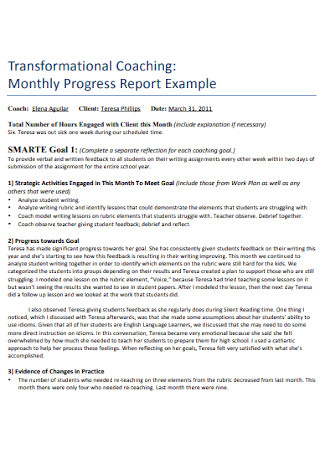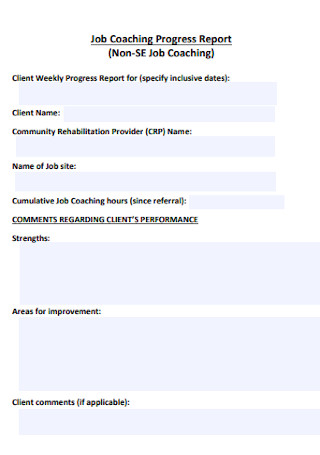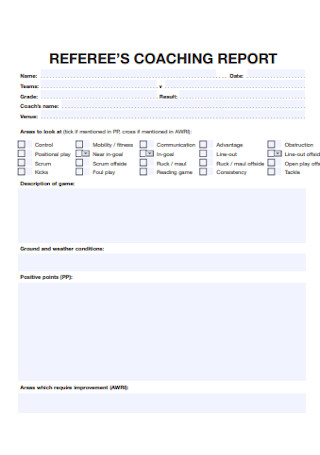The moment a particular organization considers funding you a grant for a specific project—congratulations! You now have the budget to accomplish something for your company and follow what the grantmakers…
continue reading
10+ Sample Coaching Reports
-

Coaching Monthly Progress Report
download now -

Life Coaching Report
download now -

Leadership Coaching Report
download now -

Coaching Report for Leaders
download now -

Instructional Coaching Report
download now -

Coaching Report Format
download now -

Basic Coaching Report
download now -

Job Coaching Progress Report
download now -

Referees Coaching Report
download now -

State of Agile Coaching Report
download now -

Coaching Summary Report
download now
What Is a Coaching Report?
A coaching report is a self-guided, comprehensive tool for planning leadership development. It is mainly intended to improve one’s performance or behavior. It is a form of goal-directed, specifically tailored learning geared toward a client’s growth. Also, it can aid in focusing the session toward lucrative avenues that may develop during the coaching process. This report contains information on the client’s development and observations throughout the coaching process. According to statistics, 90% of participants believed that coaching was a wise use of their own time and organizational resources. Eighty-six percent of participants thought that coaching benefited both individuals and the business considerably.
Benefits of Coaching
If you tried a coaching association, you’re aware of the numerous benefits of participating in the process. Personal coaching benefits are multiple and can positively impact an individual’s career if they engage with their coach. This technique can aid in developing individuals with a variety of requirements and can even benefit them personally. Coaching has been shown to increase confidence, enhance job forms and their performance, and foster the development of practical communication skills. Benefits can be considerably more extensive and tailored to an individual. The following are six benefits of coaching for individuals in your organization.
Tips on Having a Successful Coaching
1. Align coaching with your organization’s fundamental values
Coaching is critical to accomplishing organizational goals. As a result, your coaching should be grounded in your organization’s fundamental principles. They develop into the rationale for your counsel and encouragement. In this manner, teaching becomes less about what you believe and more about reiterating the culture you desire in your firm. When you and your staff consider the broader picture together, you should find that they are more responsive to you as well.
2. Recognize the factors that encourage your staff
It is acceptable to question them directly, in a one-on-one meeting, what motivates them. Alternatively, you might disseminate a questionnaire to all of your staff simultaneously. Engage in informal chats to learn about their weekend activities and interests. They are more ready to go above and above for a leader who cares about their well-being. Coaching has a human component. A football coach who yells at his players may discover this method counterproductive. If the coach instead appeals to the player’s background, they may speak the individual’s language and encourage the athlete more effectively.
3. Maintain a collaborative spirit
Regardless of the situation, coaching conversations should be two-way with adequate opportunity for mutual input and debate. In this manner, you avoid absolving your staff of their responsibilities or performing the work for them. Collaboration in coaching focuses on the relationship and teaches you how to serve as each other’s sounding boards. When you develop strong coaching connections with your employees, you can significantly improve your interactions and make management much more accessible. Effective coaching can help both parties create a greater sense of trust and maintain the door to progress open at all times.
4. Recognize the dynamics of your team
As a coach, you surely do not want to assign people to projects that do not get along. If this is unavoidable, assist them in establishing common ground. Ultimately, your objective is to maximize the value of the company. It all comes down to effective coaching action plan. Success is highly improbable if you are unwilling to spend your time, energy, and abilities coaching an individual.
5. As much art as science
Coaching is intended to assist everyone in achieving success. Effective coaches inspire and listen. They develop solid, trusting relationships by getting to know their customers and producing excellent communication skills. Coaches must work alongside employees or accept responsibility for bad performance. You can teach anyone how to accomplish something by providing a step-by-step tutorial. However, you cannot coach everyone in the same manner. Specific individuals require more visual teaching, while others are auditory. Due to the diversity of elements and people, coaching can be as much an art as science. However, when done right, coaching can help both your staff and your business win in the end.
How To Conduct a Coaching Session
Coaching people is critical to developing and retaining a self-motivated workforce. At first, it will take more time – the entire process of teaching a man to fish vs. simply catching a man a fish. However, the advantages are well deserving the effort. The more skilled you are as a coach, the more prepared your team is to accomplish their objectives. Successful coaching directs people in the right direction and encourages independent thinking and teamwork to solve problems. This results in the development of a trusting connection and the empowerment of the team to act proactively. This fundamental coaching will serve as the cornerstone for developing and maintaining sound procedures. These aspects work in concert to propel your business to new heights of success. Follow these steps to improve the effectiveness of your coaching and feedback processes.
-
Step 1: Determine your objectives
Before approaching your staff with a new project planning, you must be clear in your mind about the objectives you wish to accomplish. Coaching employees is frequently a two-way street. Either you are coaching them for improvement or coaching them on a new method or topic that requires instruction. Whatever the rationale, place a higher premium on the ultimate result than on how you believe they should arrive. Consider the big picture. How will this influence your company’s top objectives? How will this affect the long-term role of your employees? If you can communicate this and the desired end, you will gain employee buy-in. Discuss your objectives and be specific about your expectations. Provide them with an image of the intended outcome, but do not provide them with the road plan to get there until they specifically request one. They may approach things differently than you do, and that is acceptable. Solicit their feedback and suggestions. Perhaps they bring something novel to the table that has not been investigated previously. Maybe they raise an issue that has not been considered once. A coach is adaptable unless it involves a conventional technique.
-
Step 2: Select the proper path
Now that the employee understands why this effort is necessary, it’s time to discuss how to get there. Establish explicit criteria for what the result should contain, as well as a deadline. Has this ever been attempted previously? If yes, is there another member of your firm or team who would be able to offer some first-hand advice? Before, during, and after the procedure, communication should occur. You mustn’t simply give them directions and send them on their way. Knowing your employees’ skill sets and areas of expertise is critical in establishing the appropriate approach. Depending on the subject, some will require more teaching than others. For instance, a New Employee performing an unfamiliar task may become irritated without extensive education. Also, an experienced employee may find the same mentoring vexing. A good coach is familiar with their students on a personal level. Understanding what motivates people might assist in persuading someone to grow or change by framing the advice most effectively. The best coaches discover the most effective training methods and inspire their teams to move in the desired direction.
-
Step 3: Maintain control of the process
Return at frequent intervals to check on progress and urge staff to raise any concerns or issues they may have. Avoid micromanagement at all costs. Be available to teach, instruct, and provide encouragement and guidance as required, but allow them to exercise their independence and autonomy. Another difficulty for the coach is reprimanding without using a negative tone. There is a narrow line between adequate support and micromanagement, and the finest coaches are adept at avoiding it. Assess the employee’s progress against the agreed-upon timetable and milestones. If you need to change the timing, communicate this to the employee and explain how critical it may (or may not) be to the project’s success.
-
Step 4: Provide feedback
Feedback is a bidirectional process. Employees are responsible for communicating any difficulties. As a coach, you must provide positive feedback on their progress and areas for improvement. Assure your staff and maintain a pleasant tone, but do not sugarcoat the message. While Giving Feedback might be difficult when the outcome is less than ideal, you must be direct and honest. If you do not, you are not doing the employee any favors. Ascertain that your personnel has access to the required resources to do the task. Assist them in overcoming any unexpected barriers or consequences that may obstruct their success. Remind yourself constantly to be supportive and to assist them during the course. Your objective is to help them in growing and learning. Occasionally, people require a dose of optimism to keep them going.
-
Step 5: Re-evaluate and re-calibrate
Meet with your employees one more time to reflect on the project as a whole. Discuss what worked and did not and what could be done the next time differently. Make time to recognize their accomplishments and celebrate their success. Positive reinforcement demonstrates to your staff that the additional effort is worthwhile and motivates them to go forward.
FAQs
What constitutes an effective report?
A well-written report is usually comprehensive and self-explanatory. This should be accomplished by avoiding duplicating facts, statistics, information, findings, and recommendations. Always ensure that your statements are complete and self-explanatory. It should provide readers with accurate information in a concise manner.
What role does reporting play?
Reports will contain important information that can assist in developing future predictions, marketing plans, budget planning, and decision-making. Also, managers use company reports to monitor development and growth and discover trends and anomalies requiring further examination.
What is an example of a formal report?
A formal report is a government-issued document that offers thorough information, research, and data necessary for business decision-making. Examples are annual reports, cost reports, incident reports, and even safety reports.
Coaching is critical for participants to develop the skills necessary to achieve their goals and be their best selves. Coaching employees is also encouraged to increase the workforce’s productivity. To assist you, download our free and ready-made Coaching Report examples. Print these, and you’re ready to go!

